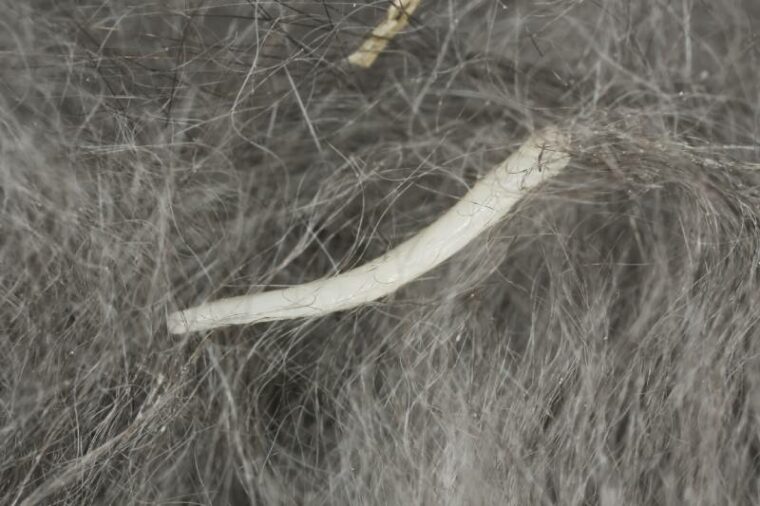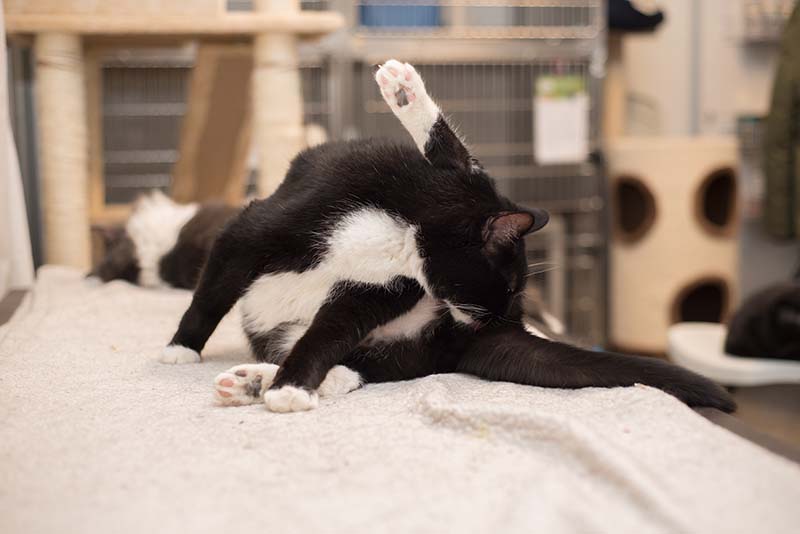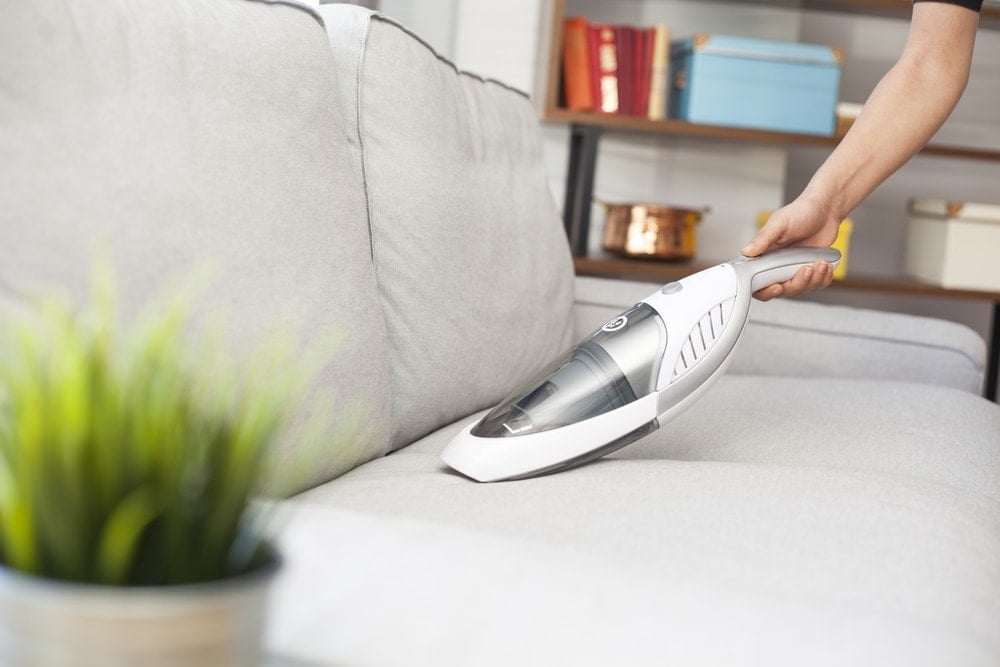
Tapeworms are parasites that commonly infect cats and other mammals. They’re usually found in their small intestines. They’re large enough to see without a microscope, particularly if you know what you’re looking for! Cats often get tapeworms while grooming by ingesting a flea that has eaten a tapeworm egg. Pets with access to the outdoors can also develop tapeworm infestations after catching and eating flee-carrying rodents or other small animals, and the egg then hatches once it reaches the cat’s intestines.

What Are the Signs of Tapeworms?
Dried worm segments can sometimes be seen in cats’ poop or stuck around their butts, and they look like pieces of uncooked white rice. Cats dealing with tapeworms often drag their butts across the floor, known as scooting. Some spend a fair amount of time licking and biting at their hindquarters. They can also vomit up worms that manage to make it from their intestines to their stomachs. Vomited worms are relatively large and are sometimes still moving.
Weight loss is rarely seen with tapeworm infestations in adults, but it can occur if the infestation is severe. If left untreated, the tapeworms can cause intestinal blockages, but luckily, they’re not difficult to treat and eliminate.

How Are Tapeworm Infestations Treated?
Deworming medication is usually prescribed to get rid of tapeworms. These medications are available as pills or spot-on treatments, and are effective. Infestations generally resolve relatively quickly after treatment, and repeated dosing is usually advised to ensure complete eradication. The worms simply dissolve, and that’s it. Most people don’t see anything in their cat’s poop.
Can Cats Become Reinfected After Treatment?
Yes. Cats who regularly hunt and come into close contact with mice, rats, rabbits, and other small animals can easily end up reinfected with tapeworms after treatment if they continue to encounter flea-infected critters. Outdoor cats benefit from regular deworming to prevent repeat parasitic infection.
The limitation of tapeworm treatments is that they only kill adult worms that are present at the time of treatment; they will not prevent further infection or stop eggs from hatching into adults. This is why regular worming treatments are recommended.
Thoroughly vacuuming all areas where pets like to relax and laundering pet bedding at high temperatures can help eliminate any fleas and their eggs that might be hiding out to prevent the cycle from starting again. Below you’ll find a few tips for addressing flea infestations at home.
The 3 Anti-Parasitic Treatments
Speak to your veterinarian about the best products to use for your cat and home. There are a multitude of flea and worming treatments out there; some are very safe and effective, others can be ineffective, others very dangerous. Flea prevention is one of the best ways to reduce your cat’s risk of tapeworm infection, and when combined with regular worming treatments, can keep your pet (and household) parasite free!
1. Vacuum
You should vacuum your entire home but spend extra time on carpeted floors, upholstered furniture, and places your cat likes to hang out. Throw the vacuum bag away immediately, preferably outdoors, to prevent fleas from escaping and reinfesting the home. If your vacuum has a reusable canister, empty it outside into a bag and drop it in the garbage can.

2. Use a Steam Cleaner
Steam cleaning often removes the fleas and eggs that might be left over after vacuuming. It’s possible to find relatively affordable hand-held steam cleaners that are perfect for tidying up upholstered chairs and pet bedding.
3. Launder Bedding
To remove fleas from human and pet bedding, wash the items in the machine at the highest possible temperature. Some cat beds cannot be thrown in the machine, but you can read the manufacturer’s instructions to find out how to safely launder pet beds and covers. Pillows, comforters, and linen from bedrooms should also get a good round in the washing machine. Drying the bedding at high temperatures is also helpful.
Are There Ways to Prevent Tapeworm Infection?
Ultimately, it all comes down to good flea protection and regular worming treatment, which is important for indoor and outdoor cats. Veterinarians can provide guidance about the right flea-control option for an individual cat’s needs. Keep in mind that cats should always be given feline-specific flea-treatment products since over-the-counter flea options for dogs contain a chemical called permethrin, which can be fatal to cats. Also, many natural options, such as tea tree oil, can be toxic to cats.
Can Cats Give Tapeworms to Humans?
According to the CDC, humans can become infested with the Dipylidium tapeworms, which are most commonly found in cats, but it’s not likely to happen. People, like cats, need to consume infested flea eggs to end up infested with this particular type of tapeworm. While cats can’t give these tapeworms to people, they can be the source of fleas that humans accidentally consume, which can end up causing parasitic infections. It’s often seen in children, and good flea control is usually the simplest answer.
Other tapeworms sometimes seen in cats include the Taenia and Echinococcus varieties. Echinococcus tapeworms can be transmitted to humans if a person consumes one of the parasite’s eggs, which are shed in infected cats’ poop. No intermediate host is required for transmission. The eggs are found in hosts such as squirrels and mice that outdoor cats often hunt.


Conclusion
Cats get tapeworms by consuming fleas that have ingested tapeworm eggs. They often consume those eggs during grooming or when eating flea-ridden prey such as rabbits and mice. The eggs hatch in cats’ digestive tracts and latch onto their small intestines. Deworming usually fixes the problem, but the worms can come back if cats keep hanging out where they can be exposed to fleas, making good flea prevention key to avoiding infection with tapeworm. Although indoor cats should also receive preventative medicine against internal and external parasites, cats that regularly head outdoors to hunt benefit from regular flea and worm protection even more.
Featured Image Credit: Henrik Larsson, Shutterstock






